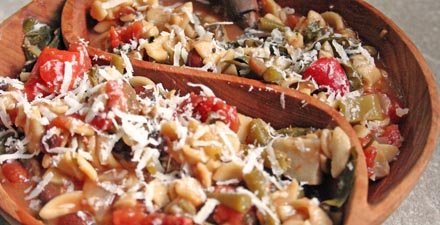
(Vegetarian, vegan option, gluten-free option)
Stock. Such a comforting word, a satisfying word. Stock means a full cupboard. It’s a dependable supply, a freezer rich with the building blocks of a dozen staple dishes. It’s the ability to weather any storm or vagary of climate.
It’s satisfying to make too, stock is. Collecting the vegetable trimmings that would otherwise wither and rot, the celery leaf and the broccoli stems. Teetering to reach the heavy stainless stock pot sitting atop the pot rack, so high it practically grazes the ceiling. Mixing the aromatics with the sweet roots and the soft greens for a balanced, flavorful broth. And when the stock is steaming in that pot, breathing in the herbaceous cloud of moisture that rises each time you can’t resist lifting the lid. It’s seeing that now, at a moment’s notice, you can whisk from the freezer a small container that will save the day.
Heady stuff, that stock. And reliable too. It’s the perfect love.
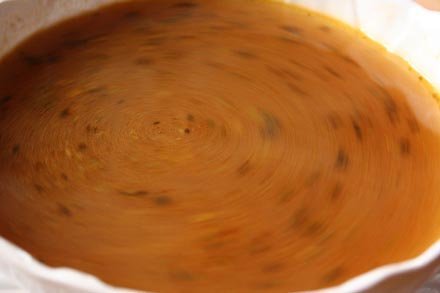
The weather here is changing. The days are brief, sun-kissed and warm, but when night steals in it demands the use of blankets. One fleeting morning, very early, I spied my breath. And then in the wake of all the coastal hurricanes, those scouring winds and battering rains that come tearing from the south! Those days, it seems as if a solid grey lid were placed snugly above our heads.
What to eat during these unpredictable times?
Here’s another favorite word: Minestrone. I don’t know how it translates, but I’d bet my last fresh tomato that it means “whatever vegetables are in the garden today”. It could also mean “could anything else possibly fit in this pot?” Whatever it literally means, when minestrone is on the stove I know I’ve got at least a week of “can my belly get any happier?”
There are endless variations on this Italian staple. The only non-negotiable ingredients, as far as I can tell, are tomatoes and beans.
In my kitchen, minestrone is a four-season soup – light and festive enough to be a mainstay during summer’s plenty, yet warm enough to soothe an unruly throat or to warm a chilled bone. And if you happen to work in one of those offices that keep the temperature set for “jacket attire”, let lunch be your warming hour. Throw in a homemade roll and minestrone becomes a dish sturdy enough to hold its own against anything winter wishes to scare up.
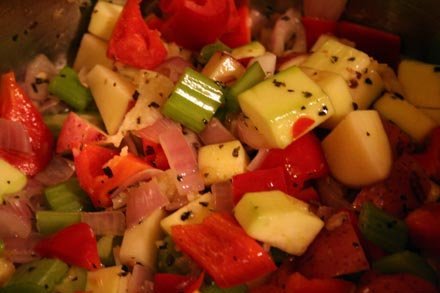
And so we come back to stock. Because any soup, and especially a vegetarian one, is only as good as the broth it’s boiled in.
I owe you all a couple of recipes. I’ve been unexpectedly away from home. It has been a summer of unexpected things, and I have missed my pots and pans, my garden and my beanstock project. Set loose at last in my own kitchen, I spent a day gleefully neglecting everything else that had piled up while I was away and instead reacquainted myself with the rhythms of my normal life. I cooked up a soupy storm.
The first thing to hit the chopping block was a full head of garlic. Purple-streaked, pungent, peppery: home. As I cooked up a turbulent cacophony of smells, a real storm, the tattered remnants of Ike, wailed outside. Simon sidled up to me in the kitchen. “Mmmm,’ he said, “you are home. It smells good in here again.”
I thought of you while I was away. To make up for my absence, I’ve got two recipes on the serving platter.
Yes, first you’ll get my favorite stock recipe. I’m sorry that it’s not simple, but some of the best things require dedication.This stock incorporates the sweet fullness of roasted veggies; this adds time and steps, but it’s so worth it. So. Completely. It’s even better if, like me, you make up a big batch and freeze it in small quantities – enough for when you next yen for a bowl of soup or a plate of wild rice (because stock is great for cooking grains too).
And then I’m going to take that stock to its next evolution as, you guessed it, minestrone. The minestrone features two heirloom beans – almost two recipes in and of itself. Friends again?
What’s this you say? No? It’s not enough? I suppose you’re right. Come back midweek, then, and I’ll see what I can do. How about two garnishes that transport this soup from comforting to elegant? And guess what? Both of these are easy.
The recipes
Over the years I’ve learned the importance of balancing types of vegetables for the right flavor. Root veggies like onion, garlic and carrots add a rounded sweetness, while leafy and green veggies like celery tops, parsley and peppers bring aroma and, well, green-ness. Roasting intensifies the flavors and gives a fuller mouthfeel to the soup base.
I’ve also come to understand that vegetables have only so much flavor to give up, and if you cook them past that point, they turn a tad bitter. Timing is crucial.
A note about ingredients. You can use just about anything, but as I mentioned above, you need a good mix of both root and green ingredients. Stock is also a forum for experimentation. For example, I wish I could like sunchokes.

Also called Jerusalem artichokes, these funny little ginger-looking knobs are rich in fiber, protein, and iron. A Native American food, they were a staple in the American Indian diet and are now being studied for their role in managing blood sugar in diabetics.
But no matter, because to me they just taste waxy. I roasted a few in my stock, and the waxy flavor is much less prominent, instead lending the stock a nutty, meaty flavor. This is further enhanced by the mushrooms.
Vegetarian Roasted Vegetable Stock
(Vegetarian, Vegan, Gluten-free)
This recipe can be doubled
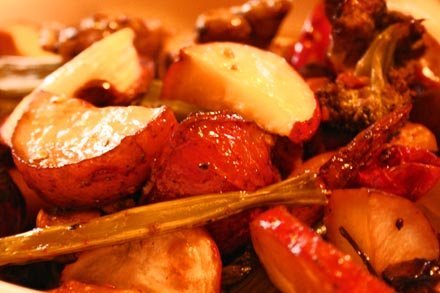
2 sunchokes (also known as Jerusalem artichokes)
4 carrots
2 large celery ribs, including the leafy tops
1 large red onion, peeled
3 garlic cloves, peeled
1 cup mushrooms, any variety
1 small jalapeno pepper, seeded and halved (optional)
2 potatoes
12 cups water
1 cup fresh parsley
1 cup fresh mushrooms
2 cloves garlic
2 celery ribs, leaves and all
2 bay leaves
Preheat oven to 430.
Cut all ingredients except jalapeno into large chunks. Spread evenly in a baking dish. Drizzle with olive oil, salt and fresh ground pepper. Splash with red wine or red wine vinegar, and stir. Place in oven and roast about 40 minutes, stirring every 15 minutes. Roast until veggies are fragrant and softly browned. Remove from oven.
Transfer veggies to a stock pot. Add the water and the unroasted vegetables (parsley, unroasted celery, mushrooms and garlic). Add the bay leaves. Bring water to a boil, then turn down to medium low heat. Cover the pot and simmer for 40 minutes, stirring occasionally.
Strain the liquid, removing as much from the veggies as you can. Season with salt and pepper if necessary. Reserve whatever you won’t use right away in containers for freezing.
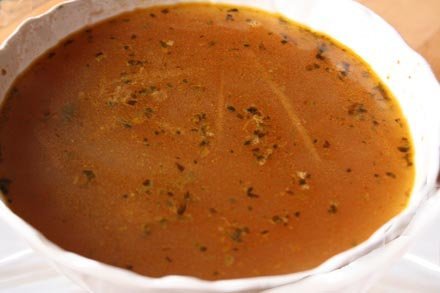
Minestrone with Fresh Blue Lake Beans and Dried Amethyst Beans
(Also known as “Can Anything Else Possibly Fit in this Pot” Stew)
We’ve already established that minestrone can consist of whatever’s hanging off the vine on the day you want to make soup. If that’s so, though, then what makes it minestrone?
To begin with, it’s the tomatoes. Minestrone always has a vaguely tomatoed broth – not quite what you’d call a tomato base, merely a suggestion of acid, with soft tomato pieces floating in the mix. They can be so fleeting that you wonder if you’re seeing things, but the flavor is unmistakable.
Then there are beans. Italians are fond of their beans, and minestrone always has dried beans and depending on the season, fresh ones too. Traditionally the dried beans are cannellinis, but just as often kidneys get stirred in. In this version, I’m using the last of my fresh green beans from the garden, the Blue Lake Bush heirloom bean. For dried, we’ve got Amethyst Beans.
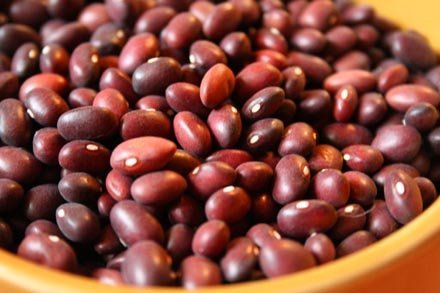
(A few words about the heirlooms. The amethyst is a jewel-purple pebble of a bean. Bought for eating from Purcell Mountain Farms, its oval shape plumps up to nearly round in the soup, and it yields a creamy, lightly fruity flavor that pairs well with the tomatoes. The Lake Bush green bean seeds were purchased from Baker Creek Heirloom Seeds. The vibrant, dark, narrow bean has been around for more than 50 years. The compact bushes grow heavy with beans that are crisp, bright and maintain their crunch when cooked.)
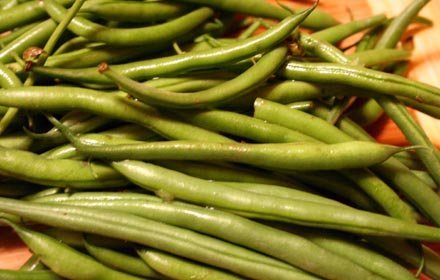
Lastly, minestrone is minestrone because of the seasonings. From the aromatic garlic to the delicate parsley and basil, real minestrone has a signature flavor. Don’t forget to dot the i in minestrone — grate a bit of fresh parmesan on top just before serving.
Minestrone
(Vegetarian, Vegan option, Gluten-free option)
¼ cup olive oil
½ large red onion, diced
4 large cloves garlic, minced
1 teaspoon dried basil
½ teaspoon dried thyme
½ teaspoon dried oregano
2 medium red potatoes, unpeeled and diced
2 celery stalks, chopped
1 red bell pepper, diced
1 small zucchini, peeled and diced
1 cup baby portabella mushrooms, sliced
10 cups roasted vegetable stock (or other vegetable stock)
14 ounces stewed tomatoes in their juice
Rind from Parmesan or Romano cheese (if you have one)
1 ½ cups cooked Amethyst beans, or other red beans
1 cup broken up bits of whole wheat pasta
a large handful of Blue Lake green beans, or other fresh beans
1 cup chopped Swiss Chard
½ cup fresh parsley, chopped
½ cup fresh basil, chopped
*Note: For vegan option, omit the Parmesan topping. For gluten-free option, omit the pasta
In a large stock pot, heat the olive oil. Add onion, garlic, and dried basil, thyme and oregano and sauté for three minutes. Add the potato and celery and stir. Cook for another 2 minutes. Stir in the bell pepper and zucchini and cook another minute. Add mushrooms, stir, and cook for one minute longer.
Add the roasted vegetable stock, the cheese rind if using, and the canned tomatoes and their juice. Cover the pot and bring to a soft boil. Add the Amethyst (dry) beans. Reduce to a soft simmer and cook until potatoes are tender, about 20 minutes. Add the broken pasta pieces (this gives the soup a creamy texture) and the Blue Lake (green) beans. Cook for another 7 minutes.
Add the Swiss Chard, the parsley and the basil. Cook for four minutes longer. Taste and adjust for salt and pepper. Remove the cheese rind.
Spoon into bowls, and if desired, grate fresh Parmesan cheese on top just before serving.And don’t forget, later this week I’ll post recipes for two garnishes that transport this soup to the next level — you’ve got my word!
